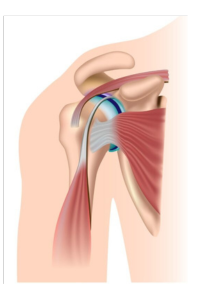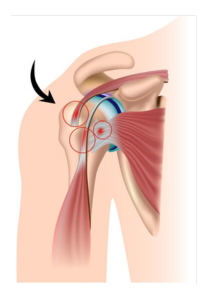Sub-acromial pain syndrome (SAPS) is a term commonly used to describe a likely cause of shoulder pain, which research shows can be the cause of 65% of all shoulder pain. The shoulder (ball and socket joint) is surrounded by a group of four key muscles and their tendons known as the rotator cuff. The main role of these rotator cuff muscles is to help the arm bone move smoothly within its socket. If these muscles are not working effectively, your arm bone can ride upwards and can lead to irritation of sensitive structures at the top of the shoulder. Sub-acromial pain can start suddenly, after an injury, or come on gradually with no obvious cause. It is not uncommon to develop symptoms around your shoulder after a period of increased use which may have overloaded these structures within the shoulder. For example: after a long day of overhead repetitive arm movement such as DIY or painting.
Pain is often felt over the outside of the shoulder and upper arm and sometimes up to the side of the neck. The pain can be worse when lifting the arm forwards or out to the side and/or with twisting movements such as putting on a coat or seatbelt. It can also often be more sensitive at night especially when lying on the painful side.
Sub-acromial pain can become more noticeable as we age often because the rotator cuff muscles become weaker. This can mean the rotator cuff may be more likely to be irritated or in some cases torn. It should be emphasised that rotator cuff tears exist commonly in the population. People over the age of 65 are more likely to have tears however many will have no pain or symptoms. Therefore, for some individuals these tears are part of the normal ageing process of the shoulder tissues. Mild to moderate rotator cuff problems usually takes between 6 weeks to 3 months to settle but can take 6 months or more in more severe cases.
Sub-acromial pain syndrome is a very well-researched condition. Current Research shows that this condition is best managed with physiotherapy and appropriate modification of day-to-day activities.



